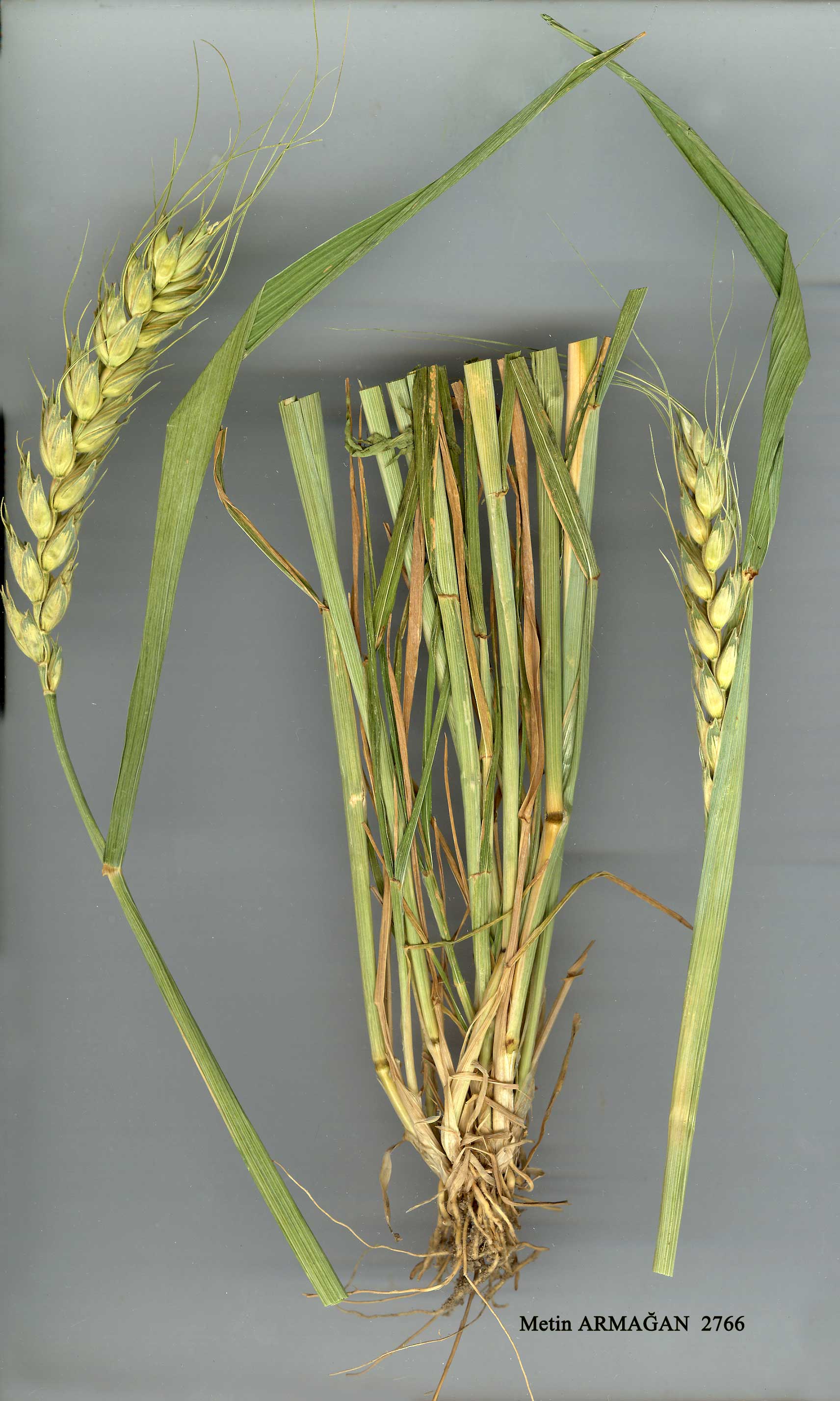| Poaceae |
|---|

Triticum aestivum L. |

Triticum aestivum L. |

Triticum aestivum L. |
 Triticum aestivum L |
Triticum L.
|
T. aestivum L., Sp. Pl. 85 (1753), nom. cons. prop. Syn: T. hybernum L., Sp. Pl. 86 (1753); T. sativum Lam., Fl. Fr. 3:625 (1778); T. vulgare Vill., Hist. PL Dauph. 2:153 (1787); T. segetale Salisb., Prodr. Stirp. 27 (1796); T. vavilovi (Tuman.) Jakubz. ex Zhuk., LaTurquie Agricole 705, 805, f. 379-381 (1933). Ic: Fl. Iraq 9: t. 67 (1968);Hubbard, Grasses ed. 2:415 (1968). Annual. Stems solitary or tufted, (14-)35-140 cm, thin-walled and hollow, rarely partly filled with pith, smooth, glabrous throughout or nodes glabres-cent. Leaf sheaths glabrous or puberulent. Ligulec. lmm. Leaf blades linear-acuminate, (4-)6-l 5 mm broad, scabridulous, green or ± glaucous, glabrous or glabrescent, margins smooth. Spikes lax to dense, (1.5-)5-10 cm, ± square in cross-section. Rachis tough, glabrous or ciliate, upper internodes (3-)4-8 mm. Spikelets 3-6(-9)-flowered. Glumes 6-10(-ll) mm (excl. awns), coriaceous, glabrous, pubescent or villous, yellow to blackish-purple;keel crested at apex or in upper half only, scabridulous, terminating in 2-3 mm acute tooth or 4-10 mm scabrid awn. Fertile lemma (lO-)l 2-15 mm, unawned or with (3.5-)6-12 cm scabrid awn. Caryopsis ellipsoid, pale coloured or reddish. Endosperm mealy to flinty. 2n=42. Fl.4-5(-6). Volcanic rock, hillslopes, chalky steppe, dry plains, by roadsides, growing with Aegilops speltoides, A. umbellulata, A. triuncialis, Triticum turgidum, Secale montanum and S. cereale, or cultivated in solid stands, 10-2500 m. Lectotype designated by Bowden (1959:674, 1962:1708): specimen 'Triti-cum 3' (BM-Hb. Cliff, photo!). . Widespread. A2(E) Istanbul: Safraköy, 19 vi 1898, Azn.! A2(A) Istanbul: Kirfez to Anadolu Hissar, 4 vi 1939, B. Post! A4 Kastamonu: Tosya, nr Suf-ler, Sint. 1892:4351 (as T. vulgare Vill. var. aestiva (L.) Spennerf. nigra Link)! A7 Trabzon: nr Trabzon, 10-1000 m, Hand.-Mazz. 254 (as T. vulgare Vill. var. ferrugineum Alefeld)! Bl Izmir: Smyrna (Izmir), Renaud! B3 Eskişehir: Eskişehir to Çifteler, Birand & M. Zohary 3297! B4 Konya: 53 km N. of Konya, 1000 m, Sorger 73-3-23! B5 Kırşehir: nr Kirşehir, 900 m, 4 vii 1902, Zederbauer (as T. sativum Lam. subsp. vulgare var. graecum Koern.)! B6 Kay-seri: 30 km S. of Kangal, 1500 m, Sorger 76-18-4! B7 Tunceli: 17 km S. of Tunceli, 1100 m, 8 viii 1972, Spencer 0401! B8 Bingöl: Varto to Çaylar, nr Eryurdu köy, 1900-2000 m, Engin 939! B9 Bitlis: Nemrut Da., 1800 m, 11 viii 1972, Spencer 0301! B10 Kars: Iğdir D.Ü.Ç., 29 vi 1967, J.G. Ross! Cl Muğla: Knidus to Datça, 150 m, Sorger & Kit-Tan 84-8-6! C2 Antalya: Acro-polis, nr Bazirgan, 24 v 1882, Luschan (depauperate)! C3 Antalya: Perge, 100 m, Sorger 63-25-7! C4 Içel: Mut, 1100 m, Doğan 176! C7 Urfa: Urfa,Sint. 1888:808! C8 Mardin: 29 km S. of Savur, 1050 m, 9 viii 1972, Spencer 0501 p.p.! C9 Van: 65 km from Gürpınar to Hakkari, 2500 m, Sorger & Kit-Tan 84-76-14! CIO Hakkari: Yüksekova, 1950 m, Duncan & Tait 198! T. aestivum, the bread wheat, is the most widespread wheat in cultivation today. Its origin through selection, polyploidy and hybridization with other species of Triticum and Aegilops is a fascinating-story no doubt familiar to most readers by now. It is a hexaploid developed from the crossing of wild emmer, T. dicoccoides with Ae. speltoides and Ae. tauschii Cosson (Syn: Ae. squarrosa auct. nonL.). Numerous varieties exist with reddish, greyish, bluish-black or pale-coloured spikes. They were described at varietal rank under T. vulgare Vill, e.g., var. erythrospermum Koern.! var. ferrugineum Alefeld! var. alborubrum Koern.! var. pyrothrix Alefeld! var. fuliginosum Alefeld! var.albi-dum Alefeld! var. lutescens Alefeld! var. turcicum Koern., etc. Forms with long awns, or completely awnless, and with glabrous or villous fertile lemmas are also cultivated. A specimen from A2(A) Istanbul (Kartal to Soğanli, 22 vi 1904, Azn.!) is said to be a natural hybrid between T. aestivum and Aegilops neglecta Req. ex Bertol. (Syn: Ae. triaristata Willd.), both of which grow in the same locality. |